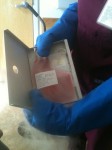Stem Cell Pioneers Converge in Portland to Discuss and Celebrate a Revolutionary New Stem Cell Entering Human Clinical …
♫ Wednesday, February 29th, 2012SAN DIEGO, CA and PORTLAND, OR--(Marketwire -02/28/12)- Medistem Inc. (Pinksheets: MEDS.PK - News) announced today its Annual "Evening with Medistem" Event will take place in Portland, Oregon on March 7th, 2012. The event is being hosted by Vladimir Zaharchook, Vice Chairman at Medistem, Inc., and will feature stem cell luminaries and pioneers working with Medistem including Dr. Amit Patel, Director of Regenerative Medicine at University of Utah and the first person to administer stem cells into patients with heart failure, Dr. Michael Murphy, Vascular Surgeon at Indiana University and Principal Investigator for Medistem's FDA clinical trial in patients with risk of amputation, and Dr. Alan Lewis, former CEO of the Juvenile Diabetes Research Foundation, advisory board member of Medistem.
In 2007 Medistem discovered an entirely new type of stem cell, the Endometrial Regenerative Cell (ERC). This cell has proven it is a "universal donor" and can be used to treat many more conditions compared to other types of stem cells. The company received FDA clearance to begin clinical trials in September of 2011 for critical limb ischemia, a condition that is associated with amputation. Medistem is also running a Phase II clinical trial for heart failure using the new stem cell. The ERC stem cell does not involve the highly controversial use of fetal tissue, can be produced very economically and administered to the patient in a very simple manner. Medistem is exploring ways to expand clinical trials of its stem cell into other diseases.
"Stem cells and regenerative medicine offer hope in clinical conditions in which hope previously did not exist," said Dr. Stanley Cohan, Head of Neurology at the St Vincent's Hospital, the largest center for treatment of multiple sclerosis in the Pacific Northwest, who will be attending the event. "We are honored in the Portland community to have this distinguished team of accomplished researchers and medical doctors convene here and discuss with us possible collaborations."
"As a long-time member of the Portland academic community, it is exciting to have companies such as Medistem to visit us and share their experiences 'from the trenches' of what it takes to push a cellular drug through the FDA," said Dr. Shoukrat Milipotiv, Associate Scientist in the Division of Reproductive & Developmental Sciences of ONPRC, Oregon Stem Cell Center and Departments of Obstetrics & Gynecology and Molecular & Medical Genetics, and co-director of the ART/ESC core at the Center. He is an internationally recognized researcher in the area of stem cells.
"The Event is an annual celebration to honor our team and collaborators for the successes of the previous year, while at the same time educate the local business and medical community on the latest research on stem cells not just at Medistem but internationally," said Thomas Ichim, Ph.D Chief Executive Officer of Medistem Inc. "2012 is particularly exciting for us due to approvals for two clinical trials, and the initiation of patient treatments within this context."
About Medistem Inc.
Medistem Inc. is a biotechnology company developing technologies related to adult stem cell extraction, manipulation, and use for treating inflammatory and degenerative diseases. The company's lead product, the endometrial regenerative cell (ERC), is a "universal donor" stem cell being developed for critical limb ischemia and heart failure.
Cautionary Statement
This press release does not constitute an offer to sell or a solicitation of an offer to buy any of our securities. This press release may contain certain forward-looking statements within the meaning of Section 27A of the Securities Act of 1933, as amended, and Section 21E of the Securities Exchange Act of 1934, as amended. Forward-looking statements are inherently subject to risks and uncertainties, some of which cannot be predicted or quantified. Future events and actual results could differ materially from those set forth in, contemplated by, or underlying the forward-looking information. Factors which may cause actual results to differ from our forward-looking statements are discussed in our Form 10-K for the year ended December 31, 2007 as filed with the Securities and Exchange Commission.

